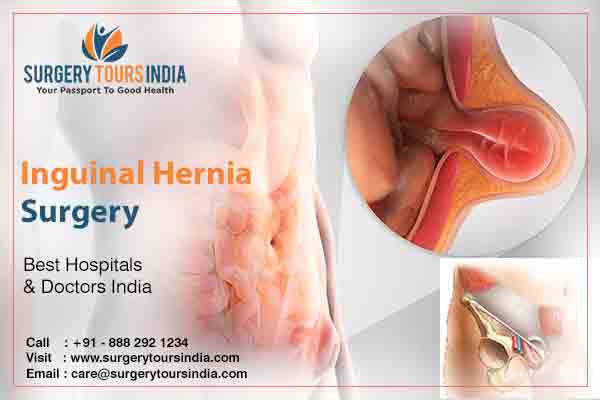
A hernia surgery is required to repair the abnormal bulging, or swelling, of an organ or fatty tissue that outs undue pressure on the muscles and connective tissue around it. Hernia can affect any part of the body, such as:
Different types of hernia may show distinct symptoms.
These are the more common signs and symptoms seen if you have an abdominal (incisional, inguinal and ventral), umbilical (intestinal) and femoral (thigh/groin) hernia:
Other uncommon symptoms of hernia include upper abdominal pain and heartburn.
The surgery for repairing a hernia is basically of two main types:
This surgery is the conventional type of surgery that requires the doctor to make an incision in the skin above the hernia and pushing the swollen and bulging organ, or fatty tissue, back in their original place. The surgeon may also use a surgical plastic mesh to repair the affected muscle tissue.
This surgery uses least invasive surgical methods to repair hernia. The surgeon will use a laparoscope (thin tube-like device with a camera and other tiny surgical instruments attached) to repair the hernia through very small (keyhole) incisions. The camera allows the surgeon to get a better view of the herniated site and the small surgical instruments are used to push back the hernia in its place and also to insert the synthetic plastic mesh to keep it in place.
This type of procedure is more preferable due to the considerably less surgery time as well as lesser pain it results in as compared to an open hernia surgery.
There are two main types of surgical procedures that are used to treat ventral (abdominal) hernia. Depending on the extent of the hernia, location and other physiological factors the surgeon will decide the type of treatment that will be most efficient and successful.
These are the types of ventral (abdominal) hernia repair surgeries:
This requires the surgeon to administer general anesthesia to the patient. The surgeon then makes an incision in the abdominal wall and pushes the bulging organ or fatty tissue back into its place. The surgeon will often use a plastic synthetic mesh to keep the organ and herniated fatty tissue in place and prevent it from bulging out.
This procedure involves using a laparoscope (a thin tube-like surgical device that has a camera and mini surgical instruments attached) to perform the surgery. The procedure starts with the surgeon administering general anesthesia. The next step requires the surgeon to make a few small (keyhole) incisions in the abdominal region through which the laparoscope is inserted inside. The surgeon uses the laparoscope to push back the herniated organ and fatty tissue into its proper place and also to enclose it with the help of a surgical plastic mesh. All this is done with the help of the thin laparoscope without any large incisions being required.
An inguinal, or groin, hernia occurs in the groin or scrotum and causes bulging of the tissue through a weak spot in the groin muscles. This causes severe burning sensation and hurts at times.
Surgery is required urgently to repair the inguinal hernia as there is a big chance that the bulging intestine may be strangulated and lose blood supply to it.
There are two types of repair procedures for an inguinal hernia surgery, these are:
This is the open-type surgery for repairing an inguinal hernia.
The procedure starts with the administering of general anesthesia to avoid discomfort and pain to the patient. The surgeon will then make an incision in the groin, just above the herniated spot. This incision is used to reach the herniated intestine, or omentum, protruding from its place and push it back into its original position.
The surgeon will perform a hernioplasty by placing a synthetic surgical mesh made of medical-grade plastic to reinforce the relocated organ in place. The surgeon will then stitch the incision close.
This is a minimally invasive type of surgical method to repair hernia disorder.
In this the surgeon will administer general anesthesia to put you to sleep. The surgeon will then make a few very small (keyhole) incisions in the abdomen. The laparoscope is a thin tube-like surgical device that has a video camera attached to its end. This laparoscope also has various tiny surgical instruments attached to it. The surgeon will use a cannula (a hard tube) to insert the video camera-carrying laparoscope to get a better view of the herniated organ or tissue.
Other incisions are used to insert the laparoscope attached with surgical instruments into the abdomen so the surgeon can push back the protruding organ or tissue into its original place. The same laparoscope is also used to place a synthetic surgical mesh to hold the swollen organ or tissue in place.
Surgery Tours India Medical Tourism Consultants have been the front runners in managing all types of hernia repair surgeries in India since a long time. The consultants at Surgery Tours India are well-experienced in managing the patient's requirement and needs to ensure smooth surgeries. Surgery Tours India consultants are also known for the excellent itineraries they organize for foreign patients seeking hernia repair surgeries in India at the lowest cost as compared to others.
For more information please contact us at
Email: [email protected]
Phone: +91-888 292 1234 / +91-9730 001 540